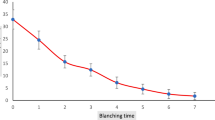Abstract
A study was carried out to detect the changes in colour and quality attributes of aonla juice during storage after pasteurization at different temperatures. After extracting juice from aonla cv. Chakaiya, it was pasteurized at five different temperatures and preserved with 500 ppm SO2 in PET bottles under ambient conditions. Juice was periodically analysed for colour and chemical characters up to 9 months of storage. Though the contents of ascorbic acid and polyphenols in juice decreased with increase in storage period, the effect of pasteurization temperature was not significant. High degree of browning was observed in juice heated at higher temperatures (90 and 95 °C) as compared to lower temperatures (75 and 80 °C) throughout the storage period as indicated by increase in NEB values. The degree of browning was further confirmed by higher negative numerical values of whiteness index in Hunter’s scale for intensity of colour. HPLC data indicated that content of gallic acid in juice decreased initially but increased sharply as the storage period prolonged. Higher amount of gallic acid was detected after 9 months of storage in juice pasteurized at 95 °C than in juice heated at 75 °C. The contents of kaempferol and caffeic acid decreased throughout the storage period irrespective of pasteurization temperature. Though least browning was observed in juice pasteurized at 75 °C, but microbial growth was observed after 9 months of storage. Hence, pasteurization temperature of 80 °C was found optimum for preservation of aonla juice under ambient conditions.




Similar content being viewed by others
References
Ayaz FA, Hayirlioglu-Ayaz S, Alpay-Karaoglu S, Gruz J, Valentova K, Ulrichova J, Straad M (2008) Phenolic acid contents of kale (Brassica oleraceae var. acephala DC.) extracts and their antioxidant and antibacterial activities. Food Chem 107:19–25
Basha SM, Musingo M, Colova VS (2004) Compositional differences in the phenolics compounds of muscadine and bunch grape wines. Afr J Biotechnol 3:523–528
Bonerz DPM, Nikfardjam MSP, Creasy GL (2008) A new RP-HPLC method for analysis of polyphenols, anthocyanins and indole-3-acetic acid in wines. Am J Enol Viticul 59:106–109
Damame SV, Gaikwad RS, Patil SR, Masalkar SD (2002) Vitamin C content of various aonla products during storage. Orissa J Hort 30:19–22
Gliszezynska SA, Tyrakowska B (2003) Quality of commercial apple juices evaluated on the basis of the polyphenols contents and the TEAC antioxidant activity. J Food Sci 68:1844–1849
Guyot S, Marnet N, Sanoner P, Drilleau JF (2003) Variability of the polyphenolic composition of Cider Apple (Malus domestica) fruits and juices. J Agric Food Chem 51:6240–6247
Haslam E (1981) Vegetable tannins. In: Conn EE (ed) The biochemistry of plants—a comprehensive treatise. Secondary plant products, vol 7. Academic Press, New York, pp 527–556
Ibarz A, Garza S, Pagan J (2008) Nonenzymatic browning of selected fruit juices affected by D-galacturonic acid. Int J Food Sci Tech 43:908–914
Jain SK, Khurdiya DS (2002) Physico-chemical characteristics and post-harvest technology of aonla (Phyllanthus emblica L.)—a resume. Indian Food Packer 47:46–49
Jain SK, Khurdiya DS (2009) Ascorbic acid content and non-enzymatic browning in stored Indian gooseberry juice as affected by sulphitation and storage. J Food Sci Technol 46:500–501
Kacem B, Cornell JA, Marshall MR, Shireman RB, Matthews RF (1987) Non-enzymatic browning in aseptically packaged orange drinks: effect of ascorbic acid, amino acids and oxygen. J Food Sci 52:1668–1672
Mehta U, Rathore H (1976) Storage studies of pressed juice from aonla (Phyllanthus emblica L.). Indian Food Packer 30:9–11
Pandey D, Misra AK 2007. Scientific Cultivation of Aonla. Extension Folder No. 2007 (3), CISH, Lucknow
Pathak RK, Pandey D, Misra AK, Mishra M (2003) Aonla for Health and Prosperity. Extension Literature 18, CISH, Lucknow
Ranganna S (1986) Handbook of analysis and quality control for fruit and vegetable products, 2nd edn. Tata McGraw-Hill Publishing Company Ltd., New Delhi
Shinoda Y, Komura H, Homma S, Murata M (2005) Browning of model orange juice solution: factors affecting the formation of decomposition products. Biosci Biotechnol Biochem 69:2129–2137
Singh S, Singh AK, Joshi HK (2006) Standardization of maturity indices in Indian gooseberry (Emblica officinalis Gaertn) under semi-arid conditions of Gujarat. Indian J Agr Sci 76:591–595
Suresh Kumar P, Sagar VR (2009) Influence of packaging materials and storage temperature on quality of osmo-vac dehydrated aonla segments. J Food Sci Technol 46:259–262
Acknowledgment
The authors are grateful to the Director and the Head, Division of Post Harvest Management, CISH for providing necessary facilities to carry out the research work.
Author information
Authors and Affiliations
Corresponding author
Rights and permissions
About this article
Cite this article
Bhattacherjee, A.K., Tandon, D.K., Dikshit, A. et al. Effect of pasteurization temperature on quality of aonla juice during storage. J Food Sci Technol 48, 269–273 (2011). https://doi.org/10.1007/s13197-010-0171-5
Revised:
Accepted:
Published:
Issue Date:
DOI: https://doi.org/10.1007/s13197-010-0171-5



